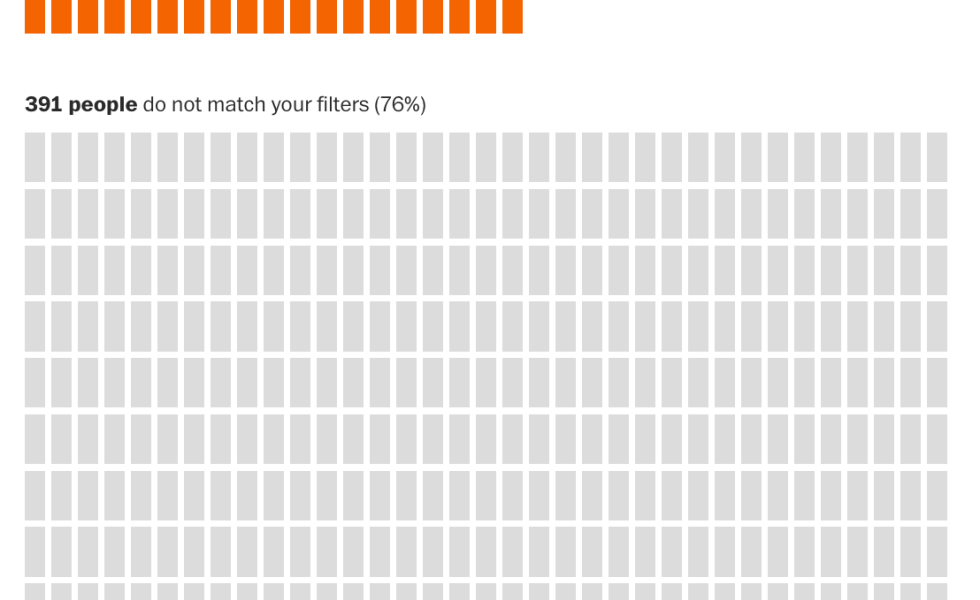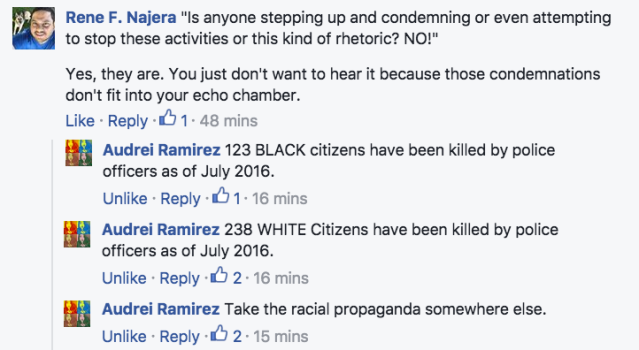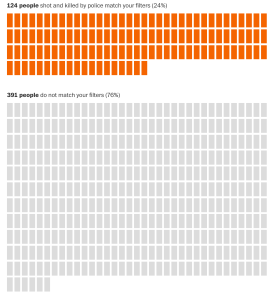Of numbers and proportions

Last week, after the events in Dallas, Texas, where 5 police officers were shot dead, the Chief of Police in El Paso, Texas, decided to make a statement. Unfortunately, he decided to label the “Black Lives Matter” (BLM) movement as a hate group. This is unfortunate because we’re at a point in history where there needs to be a discussion between two groups: Police Departments and the people they serve. Community relations in many police departments are in trouble — to say the least — and work needs to be done to repair the bad feelings floating about.
Today, the Chief issued a statement to clarify what he meant. As usual, we all misunderstood him:
“The remarks I shared after Friday’s press conference were made during an emotional time, I hope everyone can respect that. I am a police officer first and foremost and it truly pains me any time an officer is killed. As Police Chief, the most difficult part of my job has been to notify wives, mothers, fathers and children that their loved one has been killed. I have had to bury five officers during my tenure and I will never forget their faces.
Having to endure that and hearing and seeing the negative actions that are taking place at some “Black Lives Matter” events truly disturb me. For example, in New York City, the protestors were chanting, “What do you want?” and the response was “dead cops.” At another protest in Minnesota, the protestors were chanting “pigs in a blanket fry them like bacon.” In Harlem and in Dallas “Black Lives Matter” supporters were cheering after police officers were killed. Is anyone stepping up and condemning or even attempting to stop these activities or this kind of rhetoric? NO! These actions directly and indirectly influence people looking to take part in negative activities. Our City supports the initial cause for the creation of “Black Lives Matter” but we do not support violence in any shape or form.
Our police forces need to know they have support and wanting “dead cops” is not acceptable. I grew up in the 60’s when racial tension was at its height and Martin Luther King was marching and NOT condoning violence in any manner. What is going on today is wrong! I work very hard to ensure accountability among my officers, our discipline boards include police administration as well as civilians. We do not accept negative actions on the parts of our officers and have put procedures in place to protect our community members as well as our officers.
Now is the time to mourn the loss of the police officers and the individuals that have fallen as part of the tragic shootings across America. There needs to be discussion and scrutiny of the real issues to better address this situation”
I made a comment about how people have come out and called out any BLM members on not saying inflammatory things. This is the comment I got:

This is the kind of thing that I usually hear about vaccine-preventable outbreaks. The antivaxxers will say something like, “If vaccines are so good, then why were there so many vaccinated kids part of the outbreak?” The question that needs to be answered in these kinds of situations is not what the absolute number is. These kinds of things require proportions.
According to the US Census, 13.3% of the US population are African American only. According to the Washington Post, 124 of 515 fatal police shootings so far in 2016 had African Americans as the victims. That’s 24% of all shootings. In 2015, the number was 258 of 990 shootings. That was 26% of all shootings.

While Audrei up there was somewhat correct in her numbers, in that there were more Whites being killed than “BLACK” citizens, the proportions tell the true story. If all things were equal, then we’d see that about 13% of shootings involved Black victims. But things are not equal, are they? For some reason — or a myriad of reasons — Blacks are being shot and killed at about double the rate as other ethnic groups.
That’s for a discussion at a later time, and possibly a different setting.
Because apparently it is suspicious when one drives a car while being black. Our former county executive has been pulled over eight times:
http://www.seattletimes.com/seattle-news/driving-while-black-even-seattles-ron-sims-counts-8-cop-stops/
LikeLike
A similar (kind of) situation happened in Anne Arundel County in Maryland. A White man kept being pulled over for being in a mostly Black neighborhood. The police’s excuse was that he was in a high crime area, so they confused him with someone seeking drugs… http://www.nbcwashington.com/news/local/Lawsuit-Md-Man-Stopped-by-Police-for-Driving-While-White-353384211.html
LikeLike
What you are neglecting to mention is that based on statistics from the FBI, black Americans commit roughly 38% of violent crime and 28% of all crime (it varies slightly by year), even though they make up only 13% of the population. Because they commit crime at a rate above their population percentage, would it not also be logical to conclude that they would be in situations where deadly force is used at a rate higher than their population percentage?
LikeLike
“Neglecting” is a harsh adjective for what I didn’t do. I didn’t neglect to mention it more than I didn’t think it needed to be mentioned. Then again, it apparently does need to be discussed. So let’s take it one step at a time.
What causes crime? Not just violent crime, but all crime? You have socioeconomic factors, where stealing food is necessary if you don’t have food to eat, or stealing money to get food becomes necessary if you can’t get a job to make money. Or if you’re addicted to a drug you do anything under the influence of that drug to continue to be under the influence of that drug. And so on and so forth.
Then there’s violent crime. What is violent crime? It’s the use of force or threat of force in the commission of a crime. So stealing food by holding a knife to the shopkeeper is violent crime. Shooting a dealer that short-changes you is violent crime. Thus, as you can see, there are levels of violent crime, both from what causes the criminal to commit the crime to what the method is of threatening or using force.
So your statistics need to be seen in a prism of what violent crimes are committed by Blacks, why they are committed, what kind of weapons are used, and what underlying social structures are in place to trigger these behaviors. (The myth that Black men are inherently violent is just that, a myth, by the way.) The whole field of criminology is devoted to understanding these nuances.
Much like the woman who just threw numbers at me, your percentages need to be explained in a broader context, a bigger discussion. So, to answer your question, it would not also be logical to conclude that they would be in situations were deadly force is used at a rate higher than their population percentage. You see, driving with a tail light out is not a violent crime. Holding a phone while being served a warrant is not a violent crime (http://lasvegassun.com/news/2015/dec/31/metro-police-investigating-officer-involved-shooti/). Answering the door is not a violent crime (http://www.chicagotribune.com/news/local/breaking/ct-chicago-police-shooting-20151226-story.html). Having a mental illness is not a violent crime (http://www.katc.com/story/30805897/update-deputy-involved-shooting-in-breaux-bridge).
I could go on for ages.
But let’s leave it at the findings of an independent investigation of published reports of police-involved homicides. Pay attention because you (or people using your logic) are mentioned (I bolded the part that pertains to you):
Thanks for reading, Brad.
LikeLike